Solarbe has held a webinar on the Future Solar Technology – Progress of High Efficiency Solar Cell Technology yesterday, which raised wide attention among the industry.
Moderated by Dr. Huang Qiang, Managing Director of Cannovation Solar, the webinar invited Dr. Martin Green from the University of New South Wales, Dr. Andreas Lambertz from Forschungszentrum Jülich, Dr. Doug Rose from SunPower and Dr. Jochen Rentsch from Fraunhofer ISE for discussion.
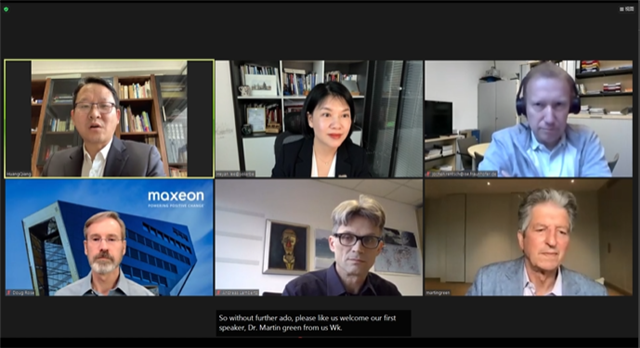
Ms. Heyan Lee, founder of Solarbe, welcomed and thanked the speakers and audience in the opening speech for their participation. She said that Solarbe will hold a series of technical webinars to hear different voices, promote exchanges and technological progress.
Dr. Huang Qiang, the moderator, pointed out that as the efficiency of PERC gradually approaches the theoretical limit, n-type has become the focus of attention. N-type technologies mainly include TOPCON, heterojunction (HJT) and IBC.
Dr. Martin Green, Professor at the University of New South Wales made a speech titled “How close can we get to 29% Si cell efficiency”. He pointed out that PERC, TOPCon, HJT and IBC cell efficiencies are likely to reach 26% and beyond in production, with better wafers of over 30ms lifetimes and improved surfaces needed to fully capture the “supercharged” FF possible from hi-resistivity wafers.
Improved contact selectivity and patterning a-Si and poly-Si are also important on the way towards higher efficiency. Then he introduced different ways to improve efficiency for PERC, TOPCon, HJT and IBC cells.
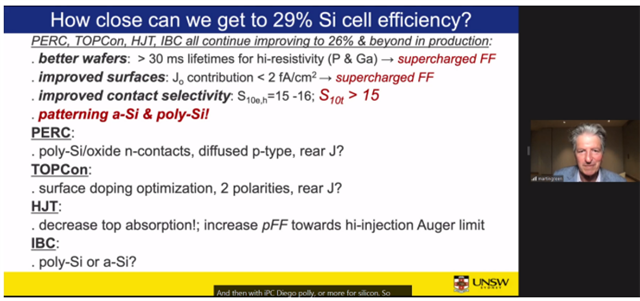
Dr. Martin Green made a presentation
Dr. Andreas Lambertz, head of the silicon HJT solar cell baseline at Forschungszentrum Jülich GmbH, spoke about silicon HJT solar cell development. He said that the increase of efficiency records for HJT cells in the last two years is enormous. HJT cells have many advantages, including high voltage and efficiency, low temperature coefficient, compatibility with thin wafers, low temperature process with only 4 steps, high bifaciality, and good partnership for tandem solar cells.
He said that a lot of companies have achieved more than 24% cell efficiency, especially newcomers like Akcome and Huasun. Manufacturers in China have planned about 60 GW annual HJT module production, and he believes it will push forward the development of the HJT technology.
It is important to reduce silver and indium consumption to lower the cost of HJT cells while improving the efficiency, he said.
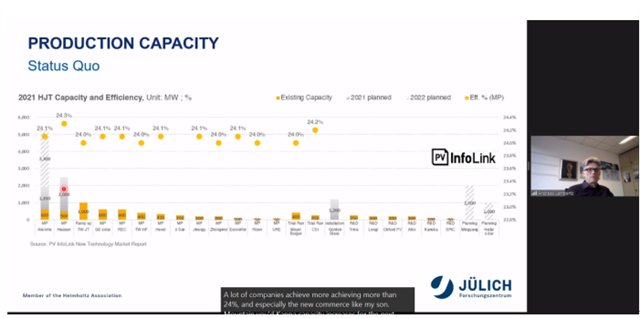
Dr. Doug Rose, Vice President of Technology Strategy at SunPower Corporation introduced the efficient and reliable Maxeon IBC cell, as well as the methodology to ensure reliability. Maxeon is a spin-out from SunPower that is headquartered in Singapore with manufacturing bases globally.
SunPower’s core product is IBC module with world-leading efficiency, low degradation rate and leading durability. The commercial total-area efficiency of SunPower modules by Maxeon Solar Technologies is up to 22.7%.
SunPower IBC cells were in three of Time Magazine’s list of 100 best inventions of 2019, including one used on solar EV. Dr. Rose pointed out that the IBC cells are well suited for to the application on EVs.
He added that, module technologies like encapsulant, glass and cell interconnect are also vital to reliability.
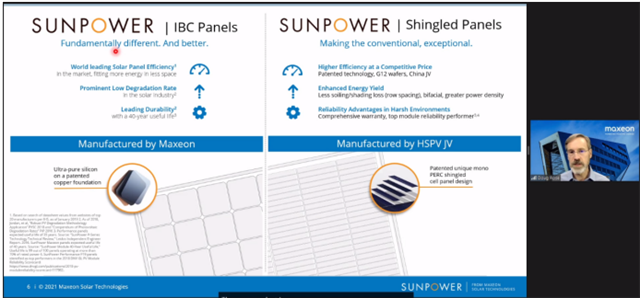
Dr. Jochen Rentsch, head of department Production Technology–Surfaces and Interfaces at Fraunhofer Institute for Solar Energy Systems (ISE) talked about the challenges and opportunities for TOPCon technology towards GW mass production.
He introduced design rules for both-sides contacted silicon solar cells, compared current status of poly-Si deposition techniques and their cost modeled for a production output of 5 GWp using M4 wafers.
He pointed out that TOPCon technology needs at least 0.4% to 0.6% absolute efficiency advantage to be economically competitive in LCOE level against bifacial PERC in mass production lines. Silver metalization cost represent over 30% of overall TOPCon cell production cost, so reduction and/or replacement of silver are necessary for multi-gigawatt expansion.
He also mentioned that plating is a very promising alternative for TOPCon in terms of sustainability and cost reduction.
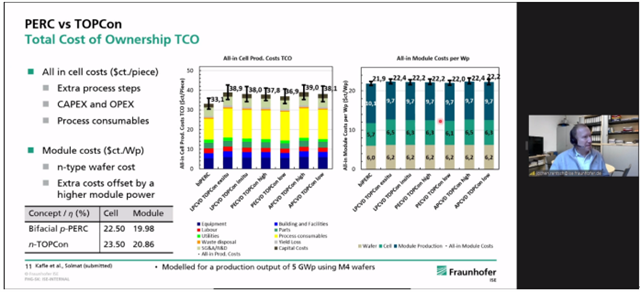
Experts also exchanged ideas during the panel discussion.
Dr. Huanq Qiang: How can we achieve over 30% of cell efficiency? Which one is the best for the bottom solar cell?
Dr. Martin Green: I think it depends on what technology you use for the top solar cell. HJT is a good choice to use in conjunction with perovskite, however, it requires low temperature. So if perovskite can’t be proved to be stable enough to use in tandem solar cells, you may need a bottom cell technology that can sustain a higher temperature.
Dr. Huanq Qiang: What are the main factors affecting the popularization of heterojunction technology? How to lower the costs below PERC?
Dr. Lambertz: I think it’s mainly about the silver paste consumption, which can be reduced in many ways, and especially equipment costs, since many companies are coming up with HJT production. So if the costs are getting lower, newcomers would like to choose HJT production as their direction, and I think in the near future the expansion will be increasing and there will be more newcomers. Wafer thickness also matters, as the wafers are getting thinner and thinner, HJT is showing its huge advantages.
Dr. Huanq Qiang: What technologies can IBC technology be used in conjunction with? What is the maximum efficiency?
Dr. Rose: IBC technology is kinda perfect and it works well in tandem, and the cell can take a high temperature, which is good to be used in the terminal situation. From an economic standpoint, instead of trying to have 26% efficiency, you might step reduce it to 24.5% to achieve better economics.
Dr. Huanq Qiang: Do you have any advice to people in the field of HJT and TOPCon on the reliability?
Dr. Rose: I guess the most important advice is just to realize the challenge of it. The key to reliability is unique for each one, which takes longer to fix because you don’t get the immediate feedback as you do with the efficiency, and the perovskite is the major challenge.
Dr. Huanq Qiang: What are the advantages and disadvantages of TOPCon compared with heterojunction technology? What is the key to cost reduction?
Dr. Rentsch: To start with the second part, the key to cost reduction, I think we need more streamlined process sequence, for example in the moment it is still a bit complex and expensive to remove some necessary additional single side action steps, which is one major step to improve cost. For advantages, if you’re in the mainstream of technology of PERC, and it’s relatively simple to upgrade to TOPCon. For the greenfield, I think it’s an open thing, whether you go for TOPCon or HJT, I think the main question will be the solution providers offer, for example the full packages, or the turnkey solutions.
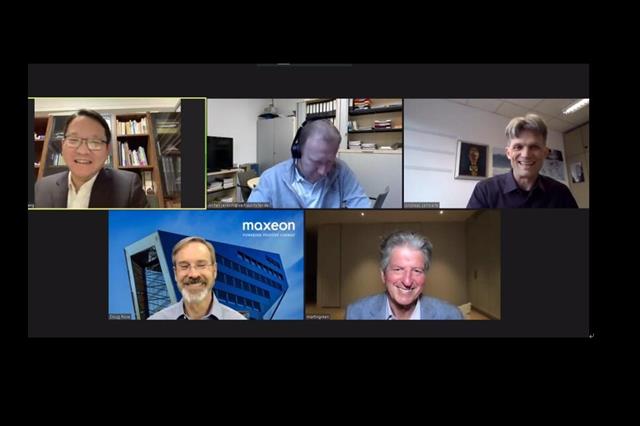
Dr. Huanq Qiang: What do you think about the module technology of these high-efficiency cells?
Dr. Rose: We had to get good at it because people hadn’t commercialized IBC cells before it’s something we focused on. We’ve seen continue progress in that and the efficiency will be over 25% for modules at some point.
Dr. Rentsch: Maybe I can add something from the TOPCon perspective, which there is no major difference between it and PERC, for example the connection techniques with multi busbars, and metalization approaches and reliability are basically same. So things can be easily applied.
Dr. Green: I think when we look at the case of bifacial tandem cells, it’s a little bit more difficult than with the single cells, because with the single cell, anything falling on the back is good, but for the tandem cell, unless in three or four terminal connections, it’s going to make matching the current in the top and bottom cell more difficult. So the tandem cell is inherently less suited for bifacial operation than the single junction solar cell and I think that probably presents an additional barrier to the commercialization of tandem cells.
Dr. Lambertz: I fully agree with other speakers and I think all the module technologies which reduce solar consumption are important. So if you are able to reduce consumption by using multi busbar and other fingers and wires, it’s all beneficial to the module design. Another important aspect I think is to make lightweight and flexible modules, which might be a big challenge for the future, but I think it’s an additional business to go for, like Maxeon’s air modules, I like them.
To watch replay: https://en.solarbe.com/home/video/info/catId/48/id/48.html


